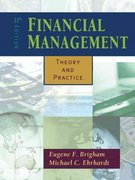Question
6. What is a practical measure that is used to quantify the risk of a single investment? a. The systematic variation b. The coefficient variation
6. What is a practical measure that is used to quantify the risk of a single investment?
a. The systematic variation
b. The coefficient variation
c. The correlation coefficient
d. The standard deviation
7. You are thinking about purchasing 1,000 shares of stock in the following firms:
Number of Shares Firms Beta
Firm A 100 0.75
Firm B 200 1.47
Firm C 300 0.82
Firm D 400 1.60
If you purchase the number of shares specified, then the beta of your portfolio will be:
a. 1.10.
b. 1.20.
c. 1.00.
d. Cannot be determined with information given.
8. Which of the following statements about bonds is true?
a. If market interest rates are below a bonds coupon interest rate, then the bond will sell below its par value.
b. Long-term bonds have less interest rate risk than do short-term bonds.
c. Bond prices move in the same direction as market interest rates.
d. As the maturity of a bond approaches, its market value approaches its par value.
9. When the intrinsic value of an asset exceeds the market value:
a. the asset is undervalued to the investor.
b. the asset is overvalued to the investor.
c. market value and intrinsic value are the same; therefore, this could not happen.
d. none of the above.
10. The discount rate used to value a bond is:
a. the coupon interest rate.
b. determined by the issuing company.
c. fixed for the life of the bond.
d. the market rate of interest.
Step by Step Solution
There are 3 Steps involved in it
Step: 1

Get Instant Access to Expert-Tailored Solutions
See step-by-step solutions with expert insights and AI powered tools for academic success
Step: 2

Step: 3

Ace Your Homework with AI
Get the answers you need in no time with our AI-driven, step-by-step assistance
Get Started


